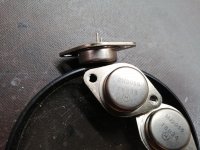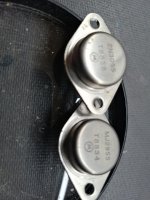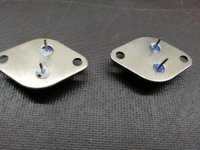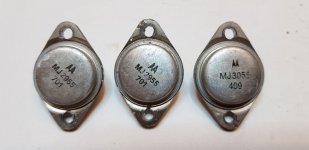Hallo all,
I need 2 pairs of hometaxial 2n3055/ mj2955 transistors to fix a Nad 3020 series 20 amp.
I gave got these and if they are the correct one's then I would not have to add base and emitter resistors as when I use modern transistors. The thing is that I do not know if these are the correct trannies, I know that they are old , they come from a ring generator that was used in manual board exchanges. Any help appreciated.
the correct trannies, I know that they are old , they come from a ring generator that was used in manual board exchanges. Any help appreciated.
I need 2 pairs of hometaxial 2n3055/ mj2955 transistors to fix a Nad 3020 series 20 amp.
I gave got these and if they are the correct one's then I would not have to add base and emitter resistors as when I use modern transistors. The thing is that I do not know if these are
Attachments
I wouldn’t be too sure. There never was any such thing as a hometaxial 2955. The single diffused processes were NPN only. I think by 1988 all Motorola made was either epi-base and it’s variants, and triple diffused for switching. Even RCA may have dropped them by then. Latest RCA’s I had were 1984. With near identical date codes, and not labeled 2N3055A (or H) I would suspect you’ve got epi NPNs. The PNPs always would have been, regardless of who made them. As long as ONE in the pair had the right internal thermal feedback it tended to stay stable.
They look genuine Motorola devices (I say "look" guardedly. Some fakes can be quite hard to spot).
Motorola never made a hometaxial device AFAIK. They had processes giving good SOA with epi base. The NPN's, are I am sure, epi devices. And they are a better complement to the MJ2955 which is epi too.
I don't have the NAD3020 circuit to hand, but I suspect it will have emitter resistors. It is not a good idea to omit emitter resistors because of thermal run-away.
You may not need base resistors, but if they are in the original I would leave them there too.
Motorola never made a hometaxial device AFAIK. They had processes giving good SOA with epi base. The NPN's, are I am sure, epi devices. And they are a better complement to the MJ2955 which is epi too.
I don't have the NAD3020 circuit to hand, but I suspect it will have emitter resistors. It is not a good idea to omit emitter resistors because of thermal run-away.
You may not need base resistors, but if they are in the original I would leave them there too.
In my stashes I found these:
These for sure are Motorola originals. I know that 'cause I bought them for an amplifier pjoject as a pupil in the 1970ies, when those we know as fakers today were still securely locked behind the iron curtain.
Look at the differences between them and those shown in post #1: My originals have aluminium caps and reinforced mounting flanges at the holes, same with other old Motorola pulls (MJ802, MJ3001...)
Unless Motorola has changed their TO-3 case design, I dare to claim that the pics in post #1 show counterfeits.
Best regards!
These for sure are Motorola originals. I know that 'cause I bought them for an amplifier pjoject as a pupil in the 1970ies, when those we know as fakers today were still securely locked behind the iron curtain.
Look at the differences between them and those shown in post #1: My originals have aluminium caps and reinforced mounting flanges at the holes, same with other old Motorola pulls (MJ802, MJ3001...)
Unless Motorola has changed their TO-3 case design, I dare to claim that the pics in post #1 show counterfeits.
Best regards!
Attachments
Yes, I have several of those old aluminium TO-3 Motorola devices. They changed their cases before ON Semi split off, but whether back to 88 I'm not sure. I've certainly got Motorola steel MJ15003/4 from 1996.
But the date coding might be wrong in post #1: Moto put the assembly plant location on the case too.
But the date coding might be wrong in post #1: Moto put the assembly plant location on the case too.
From 84 to 88, Motorola used a steel case with a shallow domed top hat similar to the aluminum. In 89 (maybe late 88) they switched to the flat-topped one in use by ON today. My 8804 2N6030’s have the domes. My 8912 2N6308’s are flat top. During the time they used the domed top hat, they switched the glass to metal seals for the pins from small to large diameter. My earliest 84’s (2N6609) have the small diameter seals like the aluminum cases have. Everything I have that predates those are aluminum.
I don't have the NAD3020 circuit to hand, but I suspect it will have emitter resistors. It is not a good idea to omit emitter resistors because of thermal run-away.
You may not need base resistors, but if they are in the original I would leave them there too.
They DON’T have the emitter resistors - which is why the RCA hometaxials were preferred. They didn’t run away as much. If you put in base resistors it usually stopped the problem if you were forced to use an epi 3055. Usually, but not always. Many people complained that the sound quality totally changed if you put in emitter resistors so no one wanted to do it. The nature of the crossover residual would be different for sure.
I bought in a 1980's Maplin 225WRMS "disco" amplifier with a few parts missing.
So I got some new 2n3055's and MJ2955's from a reputable dealer.
However, the amplifier oscillated a bit.
I increased VAS capacitor a bit and the problem went away.
I also designed a similar amp using modern transistors and that oscillated too.
This time I found I needed 10R resistors in the base of the outputs to stop oscillation.
So I got some new 2n3055's and MJ2955's from a reputable dealer.
However, the amplifier oscillated a bit.
I increased VAS capacitor a bit and the problem went away.
I also designed a similar amp using modern transistors and that oscillated too.
This time I found I needed 10R resistors in the base of the outputs to stop oscillation.
The 1980 Allen S100 amps I re-e-capped in 2018 had two original Moto MJ802+MJ4502 each. I think they looked like post 1, not post # 6. I'll check down at the church tomorrow or Thursday. Allen used screw terminal blocks & fork lugs for speakers, not 1/4" phone jacks, so I suspect they are original 1980 parts.
Last edited:
OK, but that suggests that the circuit operated without a decent quiescent current in the output stage, running the OP devices in Class B. If emitter resistors were added without adjusting the IQ then I would not be surprised if crossover distortion got worse.They DON’T have the emitter resistors
The MJ2955 was never a hometaxial base device anyway. I'm surprised that the hometaxial 3055 devices woudl have given better stability, unless their Vbe was higher compared with the epi 3055. That would tie in with a low quiescent bias.
I would suggest that adding emitter resistors and adjusting the bias would reduce crossover distortion.
The hometaxial 3055 has a high base spreading resistance, which acts like a base stopper. Which is what the original NAD relied on for thermal stability. The 2955 didn’t have that, but you really only need one to have thermal feedback. The high Rbb is also part of why fT was so bad for a given input capacitance. It tends to chop off the high frequency response.
- Status
- This old topic is closed. If you want to reopen this topic, contact a moderator using the "Report Post" button.
- Home
- Design & Build
- Parts
- Hometaxial 2n3055/mj2955



